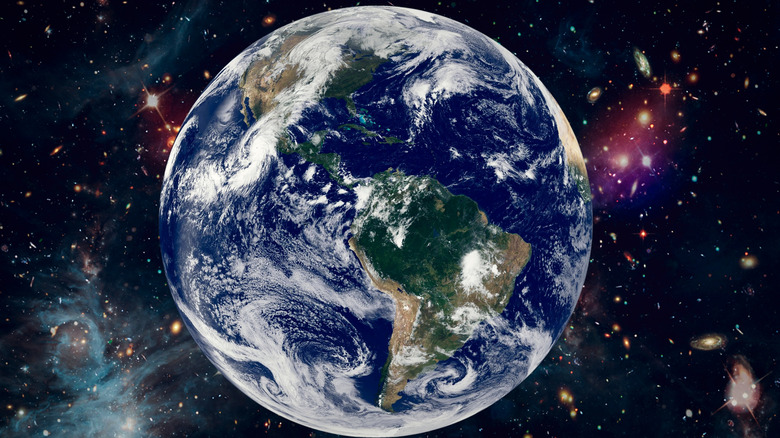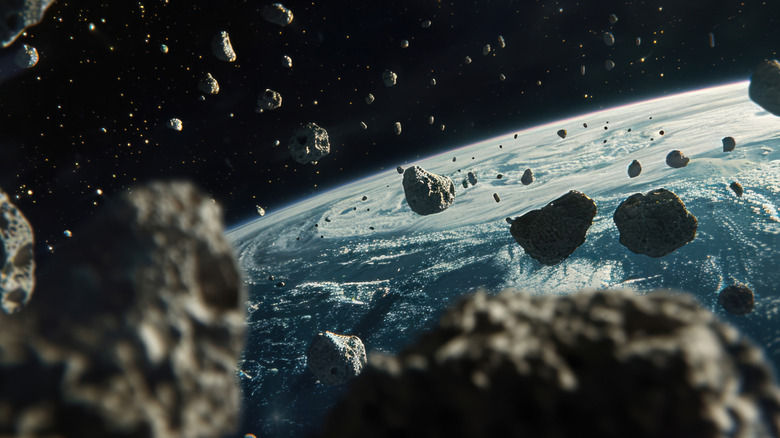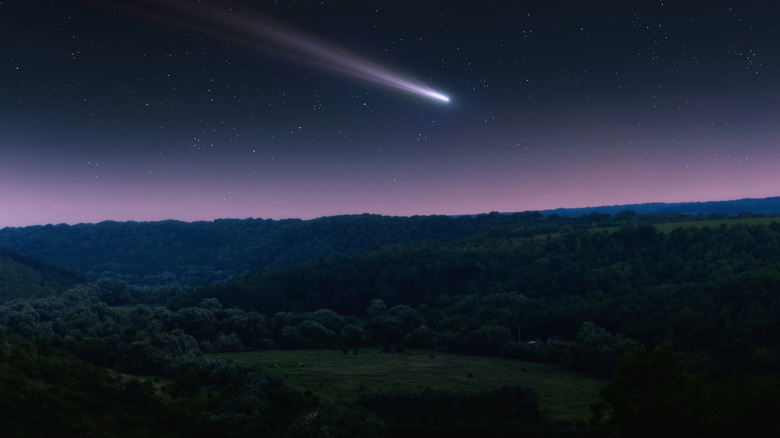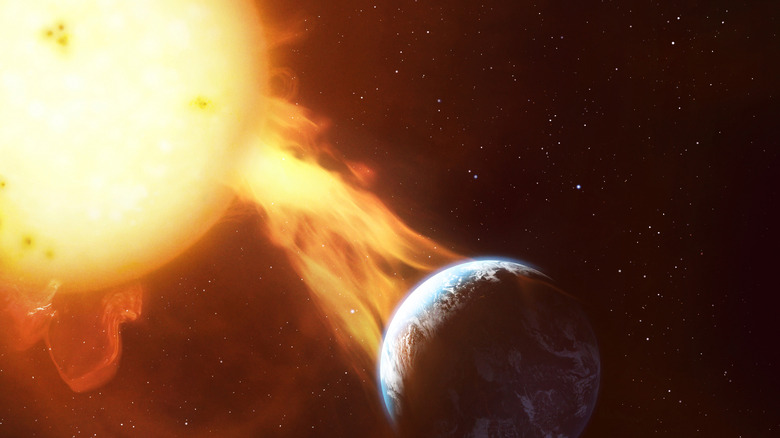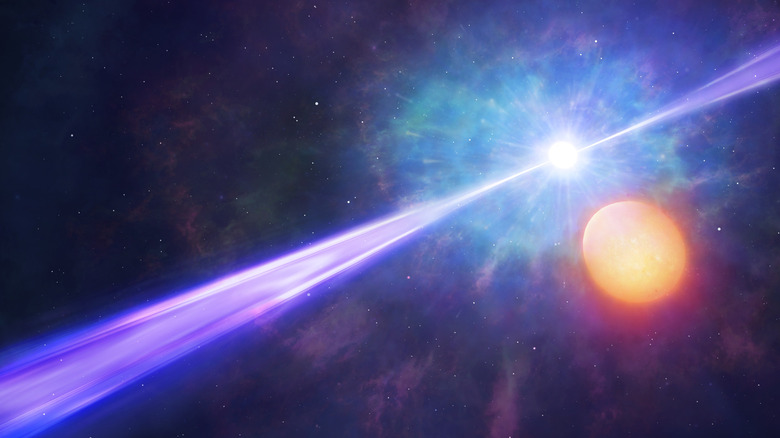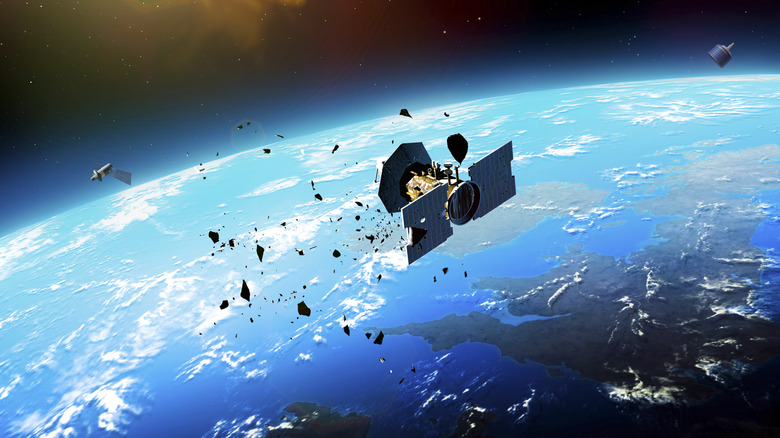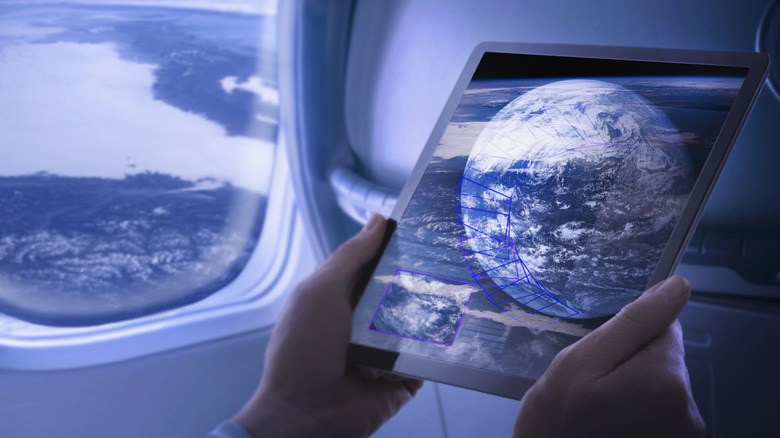6 Biggest Threats To Earth From Space
From the broader threats of climate change to everyday dangers, such as traveling, humans encounter a variety of hazards on a regular basis. While it's not healthy to be anxious about these threats per se, it is a good idea to keep tabs on them to protect life and property. However, many of us are so focused on immediate threats that we may not give any dangers outside of our planet much thought.
While space threats don't pose immediate, regular issues for Earth, it is still worth making note of the ones that could endanger the life of our planet. Among these include ancient threats that have always been orbiting the planet, as well as relatively modern, human-driven space threats. The good news is that scientists from a broad range of agencies regularly monitor such dangers to Earth from space, and they are already devising solutions for possible scenarios. Still, while you don't need to let these dangers keep you up at night, it's still worth knowing some of the more likely threats from space.
Impacts from asteroids and meteors
Asteroids are relatively commonplace items in space. These small rock formations are thought to be composed of remnants from when our solar system first developed over 4 billion years ago. They also exist in a variety of sizes, with the current largest asteroid, Vesta, measuring 329 miles wide. Like Vesta, NASA names and keeps track of most of the asteroids in orbit, with other examples including Apophis, Eros, and Psyche, just to name a few. When asteroids break apart, they can form meteors, bodies made up of rocks. The majority of meteors that approach Earth are small, and they burn up in the atmosphere without any further threat, but any larger rocks that could reach the ground could cause devastating ecological and geological effects.
The good news is that humans have developed the type of technology needed to closely track asteroids, and we also have time to come up with solutions before these rocky bodies could potentially threaten Earth. NASA monitors such threats carefully, including the likelihood of impacts, as well as possible effects such as ground explosions or tsunamis. What's more, scientists also assess the overall potential dangers based on the size of the asteroid. Researchers are continuing to develop impact scenarios, as well as possible methods of rock diversion from the earth, though it should be noted that an impact currently seems unlikely; an asteroid big enough to level a city has actually missed Earth in recent history.
Comets
While not as common of a threat as asteroids, comets can occasionally make their way into the vicinity of Earth. Also unlike asteroids, comets are made up of a mixture of dust and ice, and they do not regularly orbit near our planet. In fact, the majority of comets have stayed past Pluto for the most part. Occasionally though, a comet might veer off course due to changes in stars or other gas-containing entities that could steer them in a different direction. Should a comet ever strike Earth, the effects could be catastrophic — so much more so than asteroids because of their large size and higher velocity.
Overall, the chances of a comet hitting Earth are small, with an incidence rate of a collision every 10 million years. Nevertheless, the possibility of this threat still exists. As with asteroids, scientists regularly keep tabs on comets and for the potential of any that could orbit close to Earth. A planetary collision with a comet could not only mean immediate deadly consequences related to a massive explosion, but long-term impacts could be equally dire. Among these include land and water changes, poisoned food sources, and significant weather pattern changes. The U.S. Geological Survey's Astrogeology Science Center regularly monitors these potential threats while also working with potential scenarios for defense systems, should they be needed.
Magnetic storms
Despite the increasing magnitude of storms on Earth, humans are used to the formation of these systems. However, there are other types of storms that could affect human activities on Earth that do not actually originate on our planet: magnetic storms. These space weather events are caused by the sun thanks to phenomena known as coronal mass ejections (CMEs), or solar flares, which actually have a rather long history with Earth. Normally, the earth's atmosphere offers protection against CMEs, but there have been instances where magnetic storms have impacted the planet. These events have the potential of impacting a variety of human activities, such as electricity and telecommunications. The strongest on record was the Carrington Event of 1859, which interrupted telegraph communications. During this storm, some telegraph equipment caught fire, and some workers were also injured. Also, the last time a magnetic storm caused this type of disruption was in 1989, which resulted in a temporary disablement of the Hydro-Québec power plant in Canada.
While magnetic storms are relatively uncommon occurrences on Earth, the events of 1859 and 1989 are reminders that these sun-induced phenomena can indeed happen again. The effects can also potentially be even more disruptive due to humans' increasing reliance on electric power and technology. Among some of the possible effects include long-term, massive power outages, travel disruptions, and loss of communication. Unfortunately, there doesn't appear to be any concrete ways to stop these events, which means having backup power systems could become even more crucial should another magnetic storm hit Earth in the near future.
Gamma-ray bursts
Described by NASA as among the most powerful phenomena in our universe, gamma-ray bursts are essentially dramatic explosions of extremely high-energy light. They were first discovered in 1963 when the U.S. used one of the functions of satellites to help monitor signs of illegal nuclear testing from space. Also known as the Vela satellites, the Air Force did indeed find compliance to recently passed treaties, but scientists also detected gamma-ray bursts. They also hypothesized that both Earth and the sun contributed to these explosive events, but how exactly the high-powered events formed and why were still a mystery. Scientists do know, however, that there are two types of bursts: short and long. Short events usually involve collisions between two neutron stars, or between a neutron star and a black hole. Long gamma-ray burst events, on the other hand, involve a much more explosive demise of a star which can sometimes form a black hole in its wake. These are also known as supernova.
Overall, scientists are still trying to learn more about gamma-ray bursts. Early in their discovery, some researchers were also concerned that the destructive ability of gamma-ray bursts could impact their galaxies, and they hypothesized that a gamma-ray burst in our own galaxy could impact Earth in some way. So far though, the closest gamma-ray burst to Earth occurred an estimated 100 million light years away, while most of the potential destruction would only occur within a 200 light-year radius of the gamma-ray burst. The bottom line is, while these explosions have the capacity of vaporizing nearby bodies, their potential threat to life on Earth is still debatable.
Space debris
While some of the threats from space are out of our control, others are the result of human activities that may literally come back to haunt us. Space debris is one such example of a space threat of our own doing. After more than 60 years of human space activities, there is an accumulation of debris from rockets, satellites, and other items that have created what the U.S. Geological Survey has aptly called a "cosmic junkyard." The trouble is, this space junk doesn't just float off into the unknown, never to be seen again. Many of these items can bump into active satellites, hit astronauts working on the International Space Station, or even make their way back to Earth as dangerous projectiles. The threat could also make space travel more hazardous during rocket launches.
It's estimated the threat of being hit by space debris is extremely small, and you are more likely to get harmed during other daily activities on Earth. For example, the odds of getting struck by space debris is one in 1 trillion, and is partly due to the fact that many of these items burn up in the atmosphere. For comparison, this is far less than the risk of getting struck by lightning, which is one in 1.4 million. Nevertheless, as space debris continues to accumulate, the threat of personal injury or property damage on Earth is a real possibility to consider in the future.
Unintentional consequences of space tourism
For some people, the prospect of space tourism is helping to make dreams of travel into space a reality. Some of the proposed missions include orbits around Earth, trips to the moon, and even possible human travel to Mars' place in the night sky in the future. However, the boom in this industry also has several climate-related consequences to consider. As space tourism is anticipated to grow in the next several years, more space debris is just one possible problem. Increased black carbon emissions (soot) in the atmosphere could pose even more dangers to an already weakened atmosphere, attributed to the increased use of rocket fuel. If the space tourism industry fails to make their missions eco-friendlier, this could indeed have disastrous effects for people and the planet, as well as crucial industries, such as agriculture.
Since a cessation of commercial space tourism is unrealistic at this point, researchers are trying to come up with other solutions to help decrease the negative impacts of this industry on the earth. Some ideas currently being explored include decreased emissions, reusable rockets, and possible carbon off-setting from the companies themselves. As with development of the rockets themselves though, some of these eco-friendly solutions may take time to become a reality. In the meantime, you might consider educating yourself and others about the benefits versus risks of space tourism in an effort to reduce this potential threat to Earth.
